Business
The airlines with the most delays
Published
2 years agoon
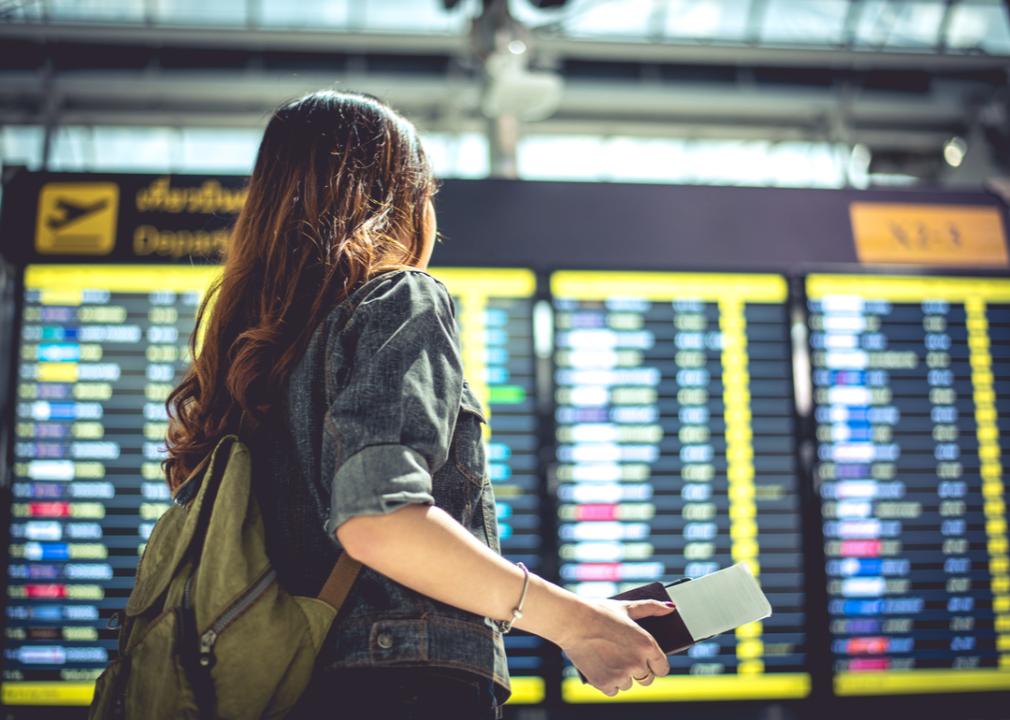
The airlines with the most delays
When you’ve already waited in line to check your luggage, waited to get through TSA screening, and then waited some more for overpriced coffee or bottled water, the last thing you want to do is wait even more for your plane to board and take off. The sad truth, however, is that air travel is a waiting game, especially if you fly with airlines or out of airports where delays are as commonplace as cramped onboard legroom and crying babies.
Stacker went through data from the U.S. Bureau of Transportation Statistics (BTS) to determine the percentage of delayed flights among all airlines. We looked at the most recent data available—reported by the airlines to the BTS from June 2021 to June 2022—and defined “delayed” as a flight that arrived at its destination at least 15 minutes after its scheduled arrival time. If two airlines had the same percentage of on-time flights, they share the same ranking. We also identified the most troublesome airport—the one with at least 100 flights during the reporting period and the highest percentage of delayed flights—for each airline.
Both mainline carriers and branded codeshare partners (airlines that only staff, maintain, and operate planes) were considered.
With the Labor Day weekend now upon us, fears over flight delays and cancellations threaten to cast a pall over what is otherwise a very popular air travel weekend. The U.S. Department of Transportation seems quite aware of such concerns and has established a Customer Service Dashboard to empower airline customers with information about what each respective airline will provide in the event of a flight disruption. This dashboard reflects very recent changes to most airlines’ policies regarding customer service plans for flights that are delayed or canceled because of the airline itself and is actively being monitored by the USDOT from a directive by the U.S. Secretary of Transportation.
While delays may yet be a necessary evil of air travel, the following may give you an idea of which airlines you can depend on for your holiday weekend plans and beyond.
You may also like: History of the supermarket industry in America
![]()
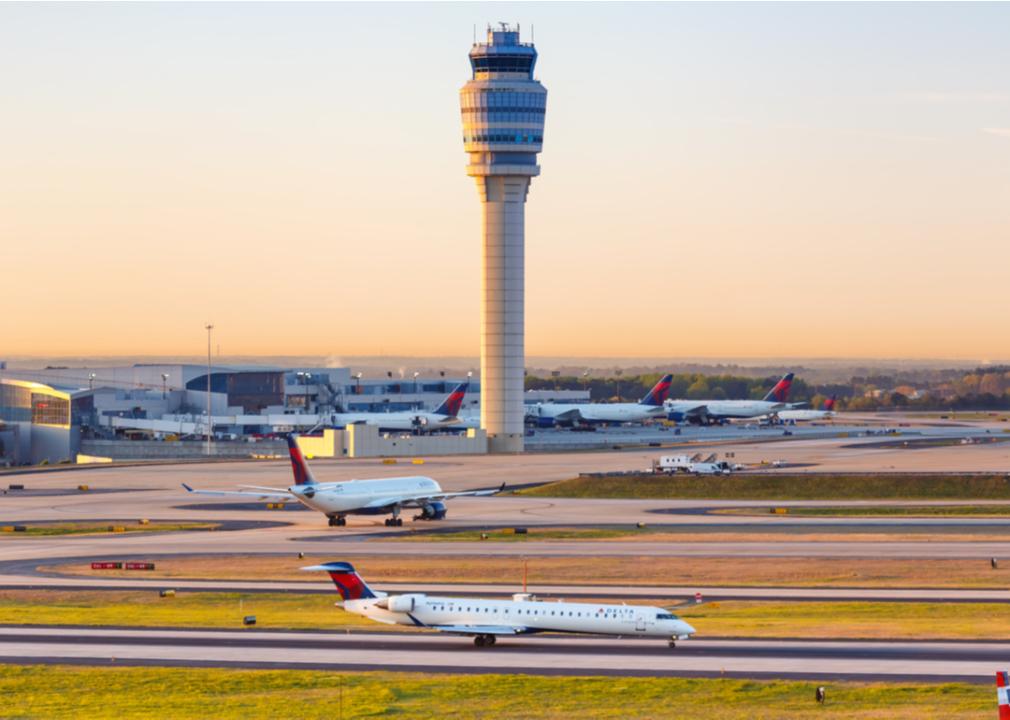
Markus Mainka // Shutterstock
#17. Endeavor Air Inc.
– On-time flights: 87.8%
– Airport with the most delayed flights: Dallas/Fort Worth, TX: Dallas Fort Worth International
Delta-owned Endeavor Air, which operates Delta Connection planes, may be under the radar. Still, it boasts the distinction of having fewer delayed flights than any U.S. carrier on our list.
Its excellent on-time status is probably due to the fact that it operates mainly from regional airports, which are subject to fewer delays due to lighter air traffic. But it also operates out of major airports, including hubs in New York City, Atlanta, Minneapolis, Detroit, and Cincinnati—and super-busy Orlando. Its 183 regional jets service 140 destinations in the U.S., Canada, and the Caribbean with 900 daily flights.
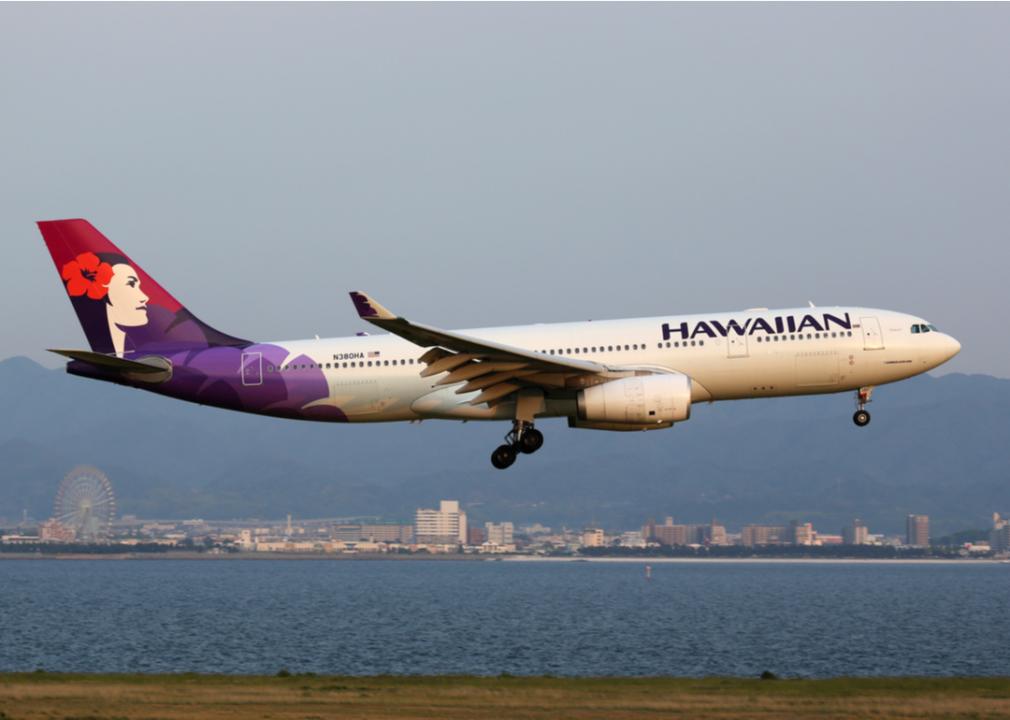
Markus Mainka // Shutterstock
#16. Hawaiian Airlines Inc.
– On-time flights: 86.8%
– Airport with the most delayed flights: Austin, TX: Austin-Bergstrom International
Because so many Hawaiian Airlines flights go to the 50th state, where weather delays are relatively rare, its on-time record is above average. Hawaiian, in fact, routinely tops on-time performance lists and receives the fewest complaints about cancellations, overbooking, and baggage-handling problems.
With the continual expansion of its routes since its launch in 1941, it now flies throughout the Pacific and the continental U.S.—even to Austin, where Hawaiian Airlines passengers endure the most delays.
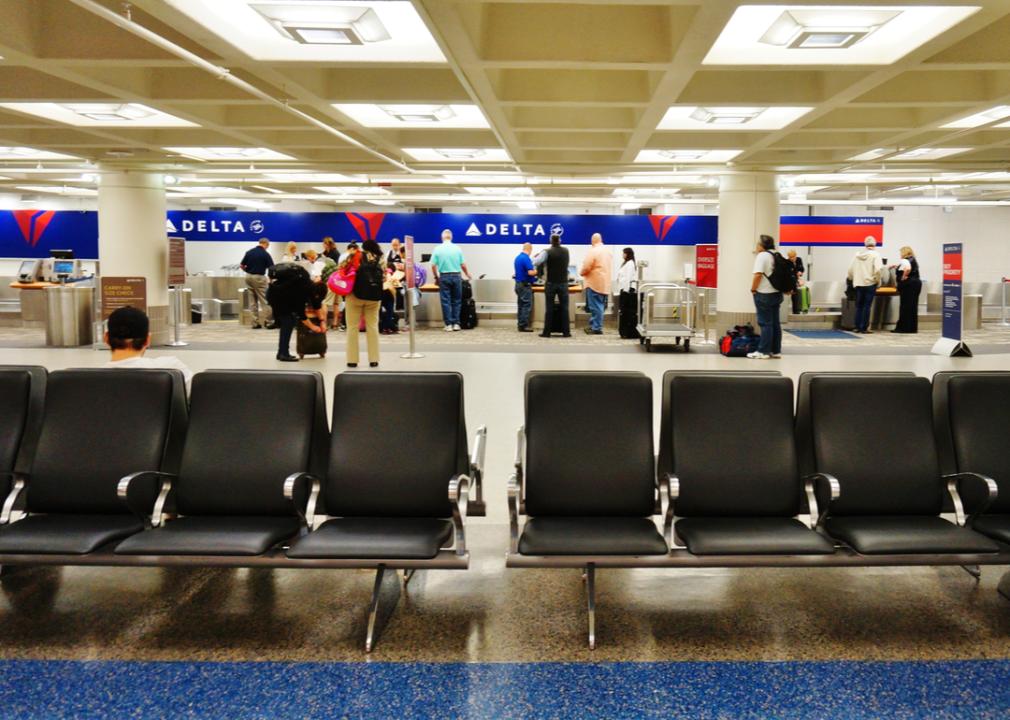
EQRoy // Shutterstock
#15. Delta Air Lines Inc.
– On-time flights: 85.4%
– Airport with the most delayed flights: Burlington, VT: Burlington International
Delta is the only airline in the top eight on our list that ranks among the five largest U.S. airlines: second in passengers carried and miles flown, third in fleet size, and fifth in the number of routes and destinations. Infrequent delays represent one reason why Fodor ranks it as the #1 U.S. airline. Its flights to Burlington, VT are delayed most often.
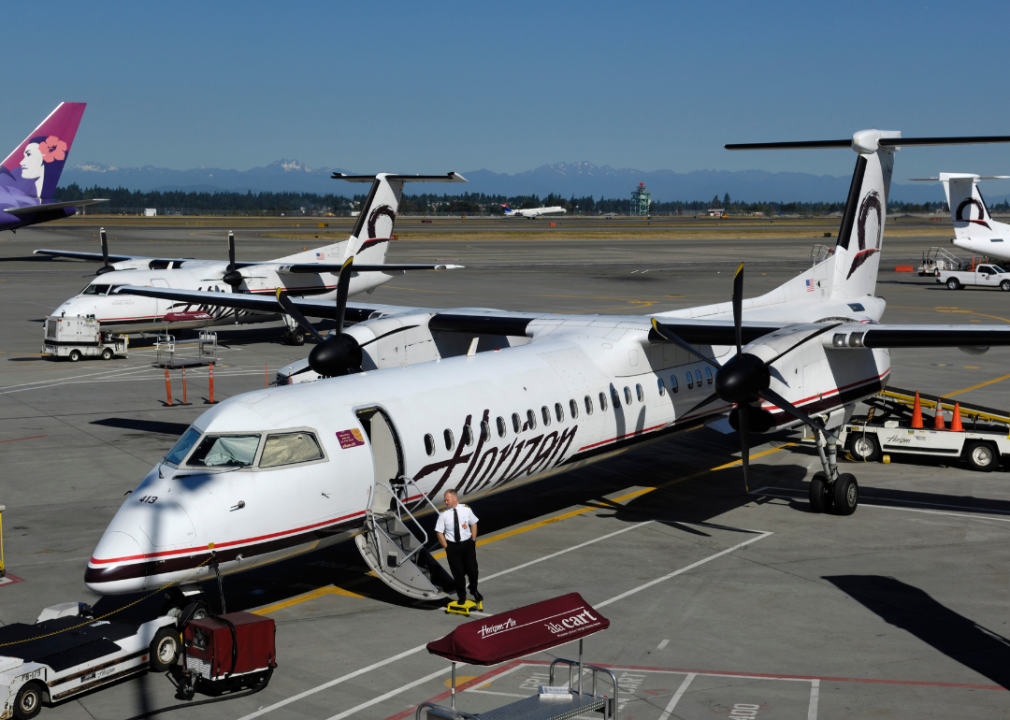
aviation-images.com // Getty Images
#14. Horizon Air
– On-time flights: 84.3%
– Airport with the most delayed flights: Salt Lake City, UT: Salt Lake City International
Horizon, Alaska Airlines’ regional carrier, serves dozens of destinations in the western U.S., Canada, and Mexico, with Milwaukee the only destination east of the Mississippi. The light air traffic in western outposts, such as Wichita, Kansas; Walla Walla, Washington; and Dillingham, Alaska, keep it on time most of the time. Horizon also flies to a handful of major western cities, which drags its stats down. Its hubs are Seattle, where it started out as a small regional carrier, and Portland, Oregon, while Salt Lake City is where you’re most likely to be delayed on a Horizon flight.
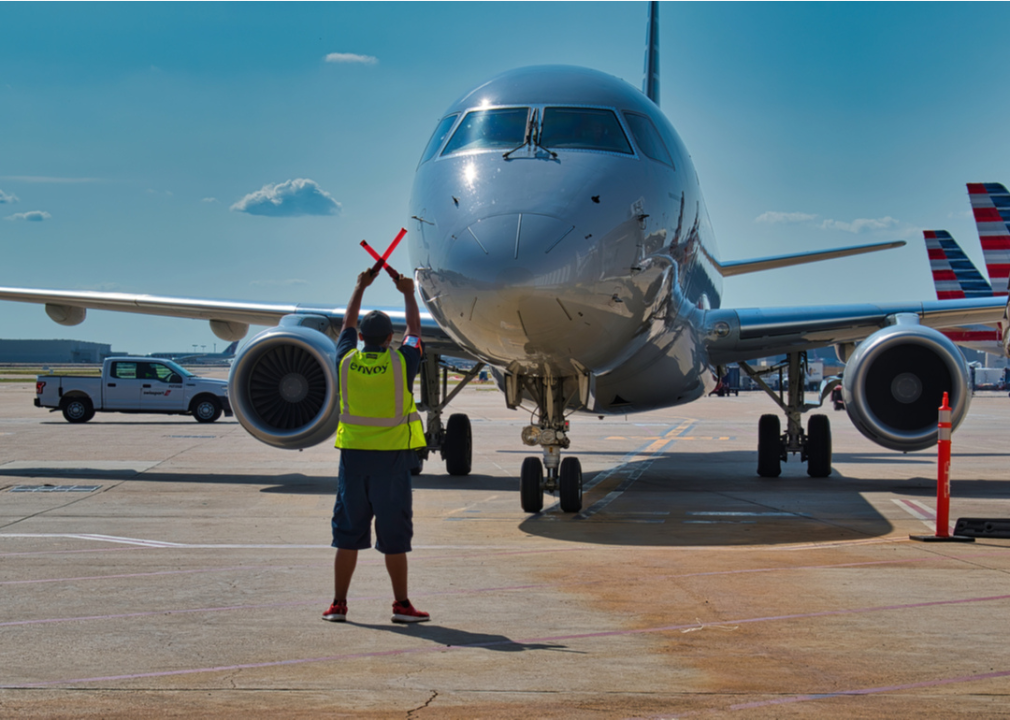
LJ Jones // Getty Images
#13. Envoy Air
– On-time flights: 84.1%
– Airport with the most delayed flights: Manchester, NH: Manchester-Boston Regional
Envoy is an airline you’ve likely never heard of because they “only” staff, maintain, and operate American Eagle planes, while American Airlines handles the sales, marketing, and scheduling of flights.
Envoy flies primarily to smaller cities—more than 150 destinations throughout North and South America, making it American Airlines’ busiest regional partner. The snows of Manchester, NH, can be blamed for Envoy’s mediocre on-time percentage there.
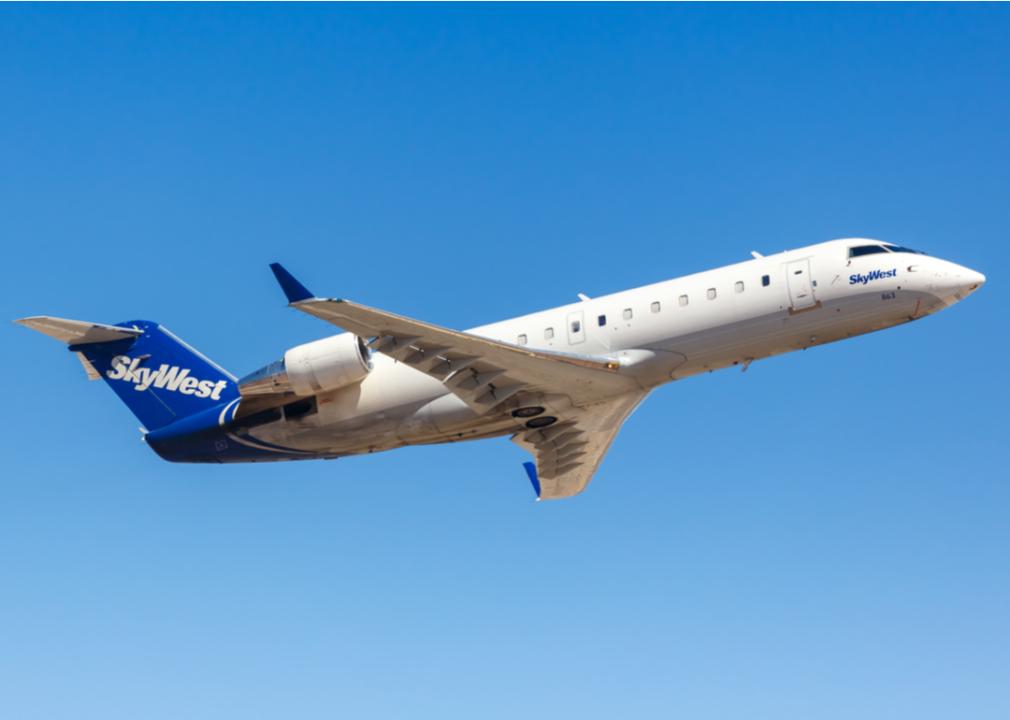
Markus Mainka // Shutterstock
#12. SkyWest Airlines Inc.
– On-time flights: 82.3%
– Airport with the most delayed flights: Panama City, FL: Northwest Florida Beaches International
Because it serves so many masters—operating flights for American, Alaska, United, and Delta—SkyWest is the busiest regional airline in the U.S. The airline delayed more than 1,300 flights in October 2021 due to a server outage.
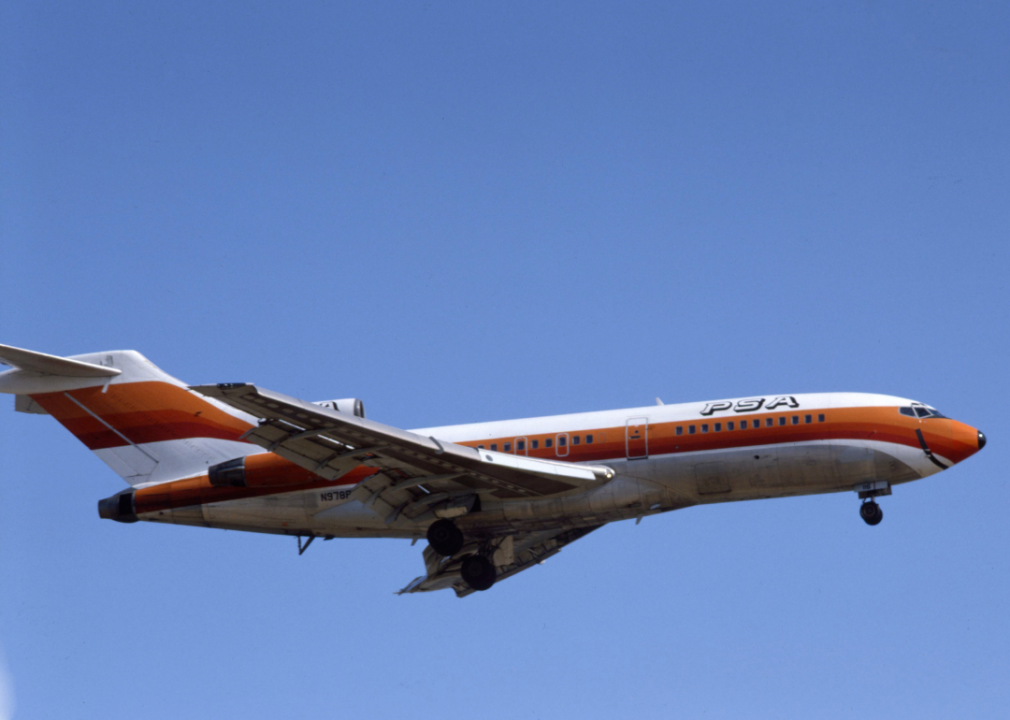
Donaldson Collection // Getty Images
#11. PSA Airlines Inc. (tie)
– On-time flights: 81.7%
– Airport with the most delayed flights: Albany, NY: Albany International
PSA operated for a few years in the 1990s as an independent airline but now operates planes exclusively on American Eagle regional routes. Almost all of its nearly 100 destinations are small cities in the eastern half of the U.S. This focus on smaller cities like Albany, NY—where winter weather delays make it the airline’s most problematic airport—generally keeps delays to a minimum.
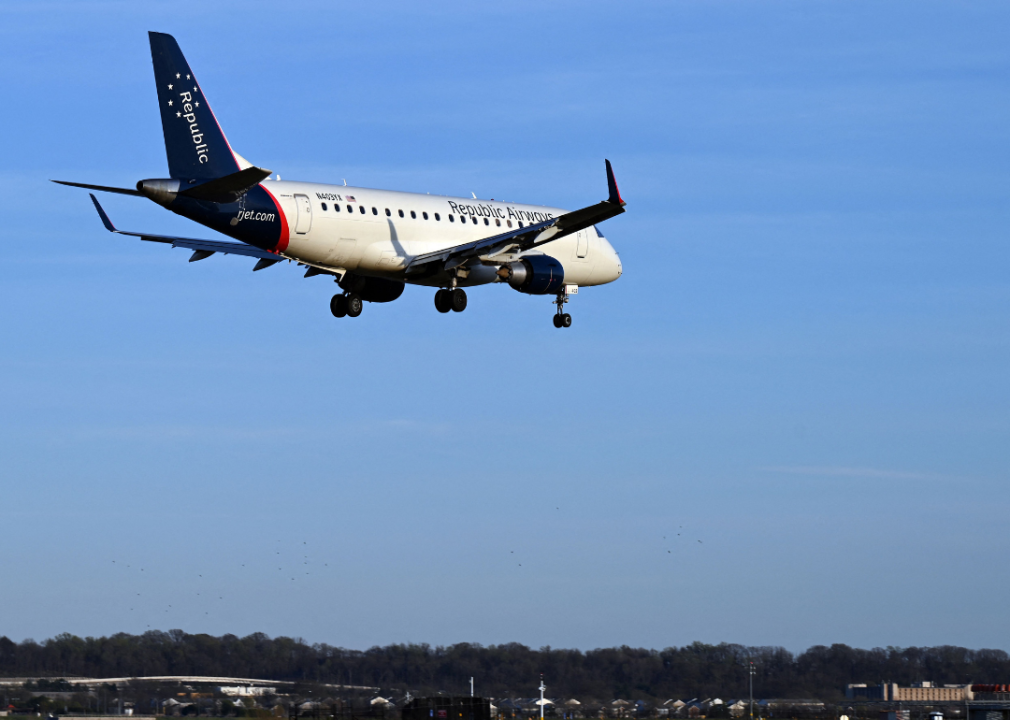
DANIEL SLIM // Getty Images
#11. Republic Airways (tie)
– On-time flights: 81.7%
– Airport with the most delayed flights: Lansing, MI: Capital Region International
You know how some wineries produce wines from grapes purchased from growers in the next county—but the growers don’t get any credit when awards are handed out? You likely haven’t heard of Republic Airways.
The airline operates regional flights on behalf of United Express, American Eagle, and Delta Connection. Republic gets credit for its reasonable on-time percentage, even though the airline benefit from flying in and out of quiet airports like Bangor, Maine, and Lansing, Michigan—where snow and ice on the runways contribute to the frequency of delays.
You may also like: Major boycotts that changed history
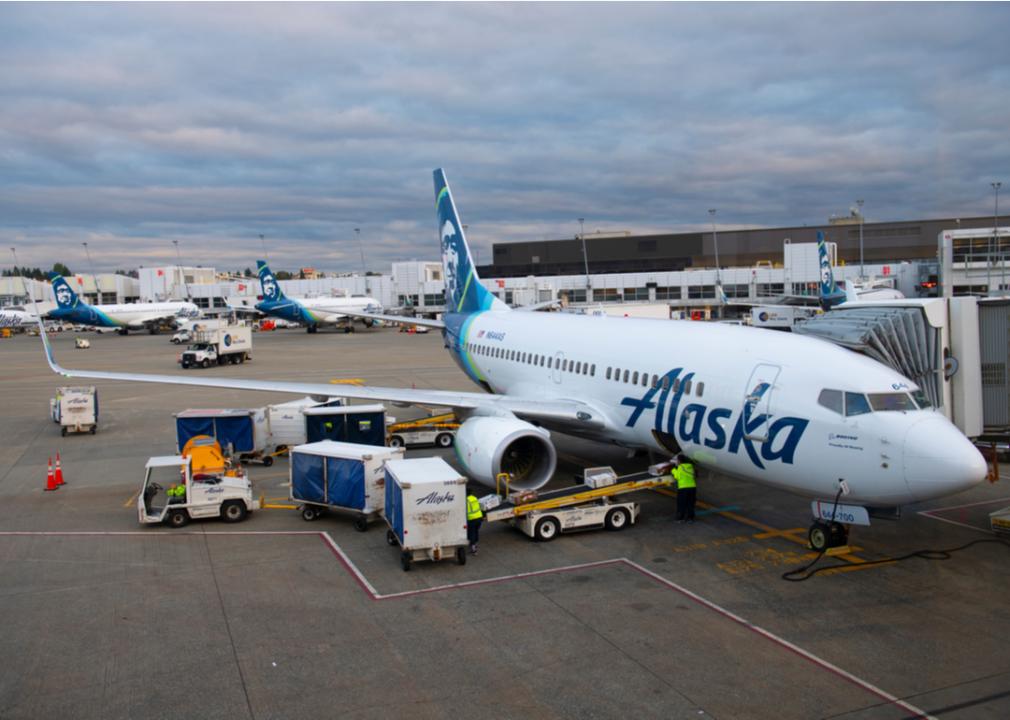
Wangkun Jia // Shutterstock
#9. Alaska Airlines Inc.
– On-time flights: 80.5%
– Airport with the most delayed flights: Dallas, TX: Dallas Love Field
Alaska is nearly triple the size of Texas, leading many Alaskans to treat flying like most of us treat driving—although blizzards and icy runways can make flying there a challenge.
It’s safe to say that if an airline can make it in Alaska, it can make it anywhere, and Alaska Airlines has indeed “made it” as a major carrier throughout Canada, Mexico, and most of the other 49 states. True to its roots, Alaska still flies to tiny Adak Island (pop. 326), where frequent delays can be attributed to the Aleutian island’s fierce winds and 173 annual days of fog.
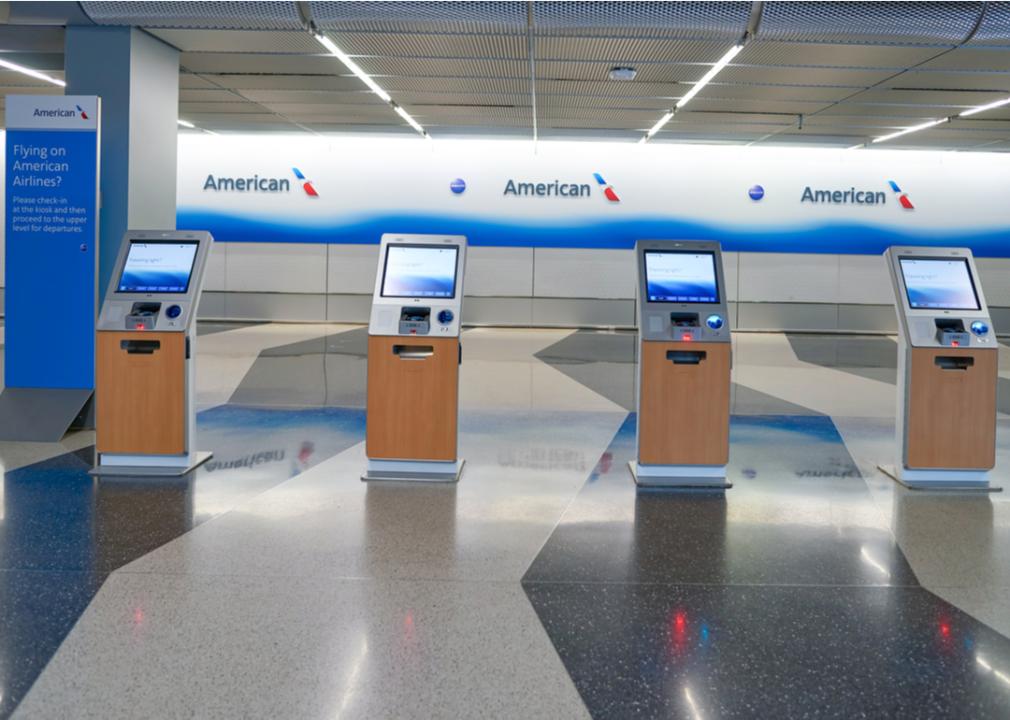
Sorbis // Shutterstock
#8. American Airlines Inc. (tie)
– On-time flights: 80.1%
– Airport with the most delayed flights: Augusta, GA: Augusta Regional at Bush Field
No U.S. airline transports more passengers than American. Its on-time performance isn’t terrible, but it’s lower than many other major carriers. Besides 230 U.S. destinations, the behemoth flies to 121 foreign destinations in 62 countries on every continent except Africa.
You may also like: 30 times history has tanked the stock market
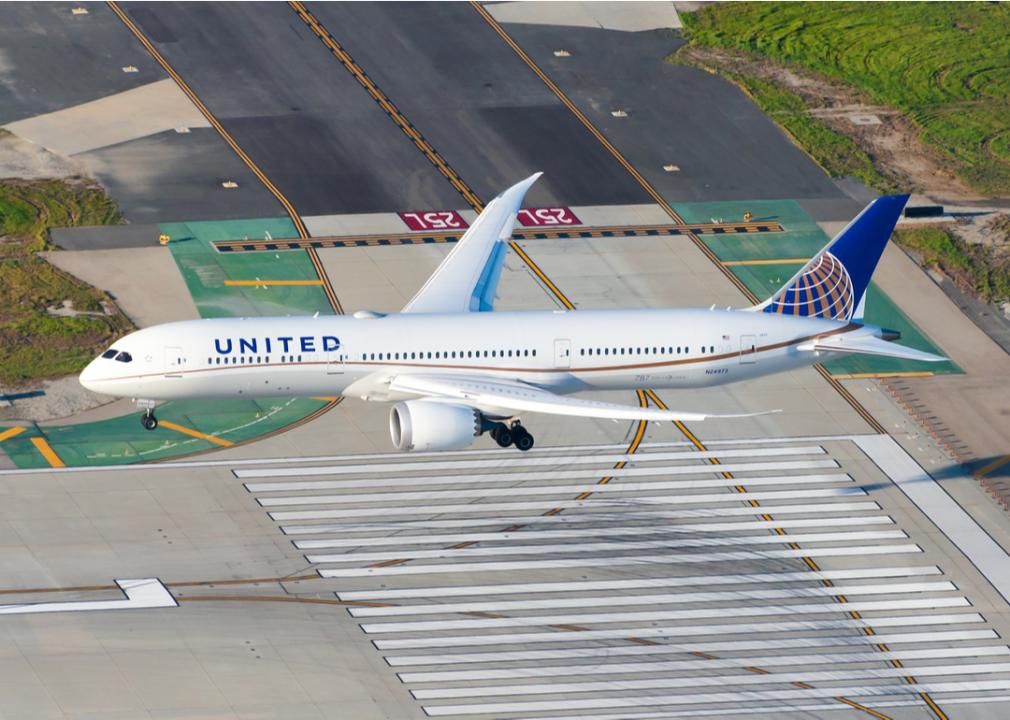
Thiago B Trevisan // Shutterstock
#8. United Airlines Inc. (tie)
– On-time flights: 80.1%
– Airport with the most delayed flights: Aguadilla, PR: Rafael Hernandez
United paid a record $1.9 million fine last year for subjecting the passengers of 25 flights between 2015 and 2021 to lengthy tarmac delays. It slipped from an 85% on-time record (third-best among major U.S. airlines) in 2010 to just 75% in 2019 before rallying to its current 80.1%. Delays in the not-so-friendly United skies are most common in Aguadilla, Puerto Rico because it’s a popular beach getaway city with only one departure gate and a 1930s runway due to be replaced.
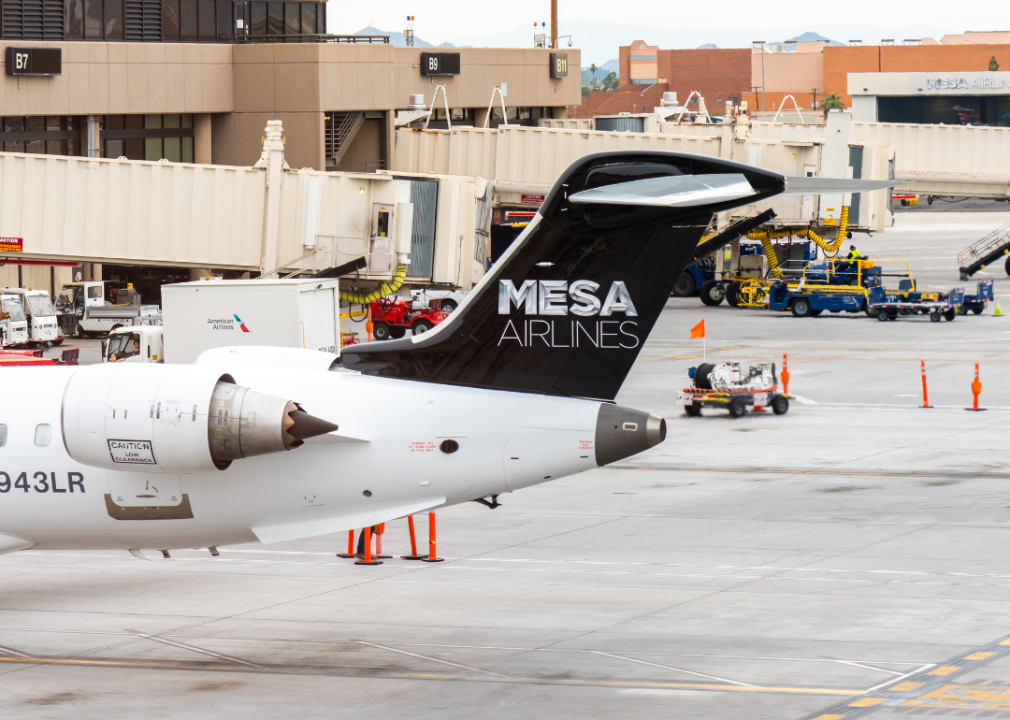
SOPA Images // Getty Images
#6. Mesa Airlines Inc.
– On-time flights: 79.1%
– Airport with the most delayed flights: Key West, FL: Key West International
Mesa is a midsized airline that operates jets for American Eagle and United Express. It became America’s first regional airline to exclusively fly large jets in 2010, with most flights transporting passengers from small airports to six U.S. hub cities: Houston, Dallas, Phoenix, Cincinnati, Louisville, and Washington D.C. If you’re itching to leave Florida, though, you might need to cool your heels for a while as flight delays leaving Key West are common.
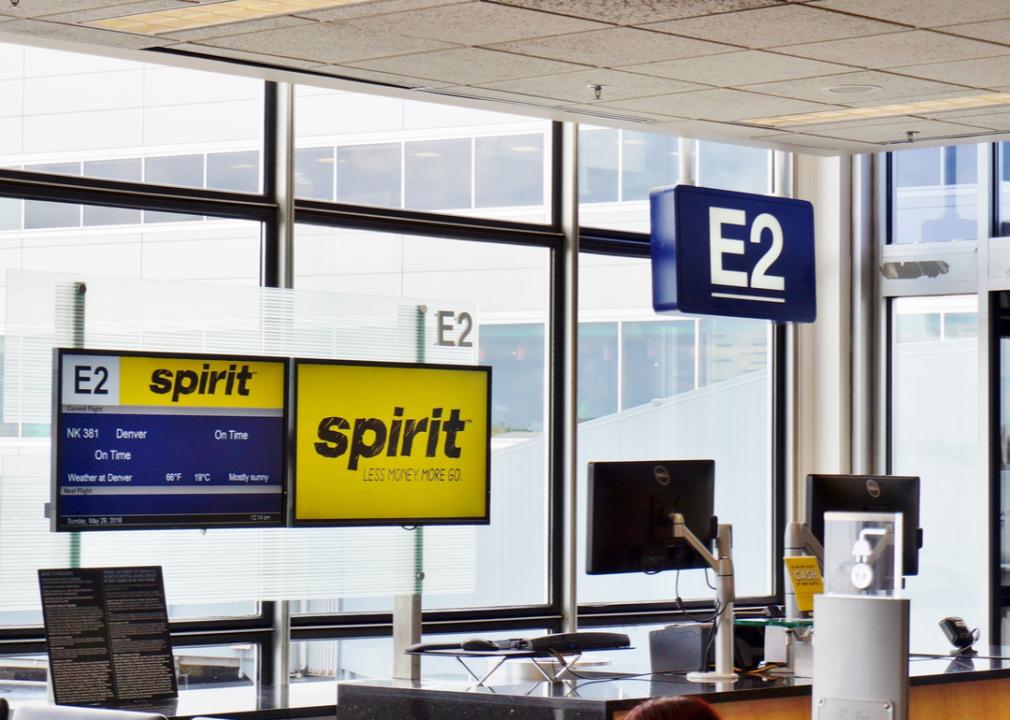
EQRoy // Shutterstock
#5. Spirit Airlines
– On-time flights: 75.5%
– Airport with the most delayed flights: Aguadilla, PR: Rafael Hernandez
If Spirit played on a Little League team, it would be awarded the “most improved” trophy. In 2017, it was dead last (68%) among major U.S. airlines for on-time arrivals. Moving up to fifth-worst on our list isn’t bad, but there is still room for improvement. Spirit is America’s largest ultra-low-cost airline. While its expected merger with Frontier went belly up, it now remains in talks to absorb JetBlue.
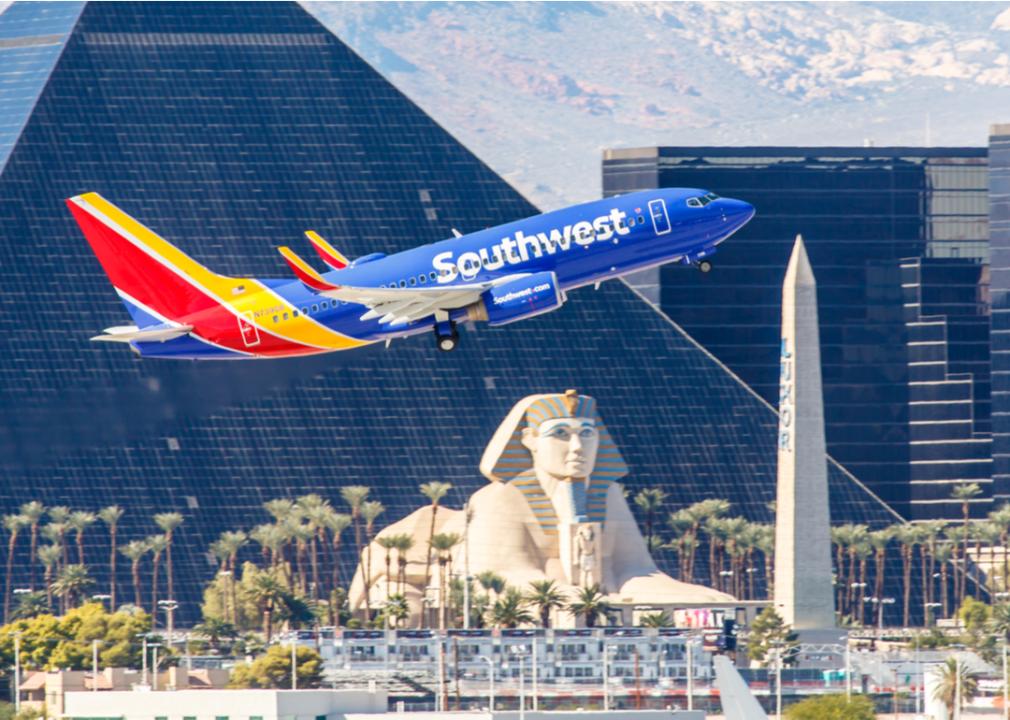
Eliyahu Yosef Parypa // Shutterstock
#4. Southwest Airlines Co.
– On-time flights: 74.9%
– Airport with the most delayed flights: Chicago, IL: Chicago O’Hare International
Southwest endeared itself to many loyal passengers with its flexible ticketing policy and free checked bags, but its propensity for delays nearly eclipses those benefits. And it does no worse anywhere in the world than at famously frustrating Chicago O’Hare, where delays are something of a regular occurrence due to snow, severe rain, staffing shortages, and simply too many flights on any given day.
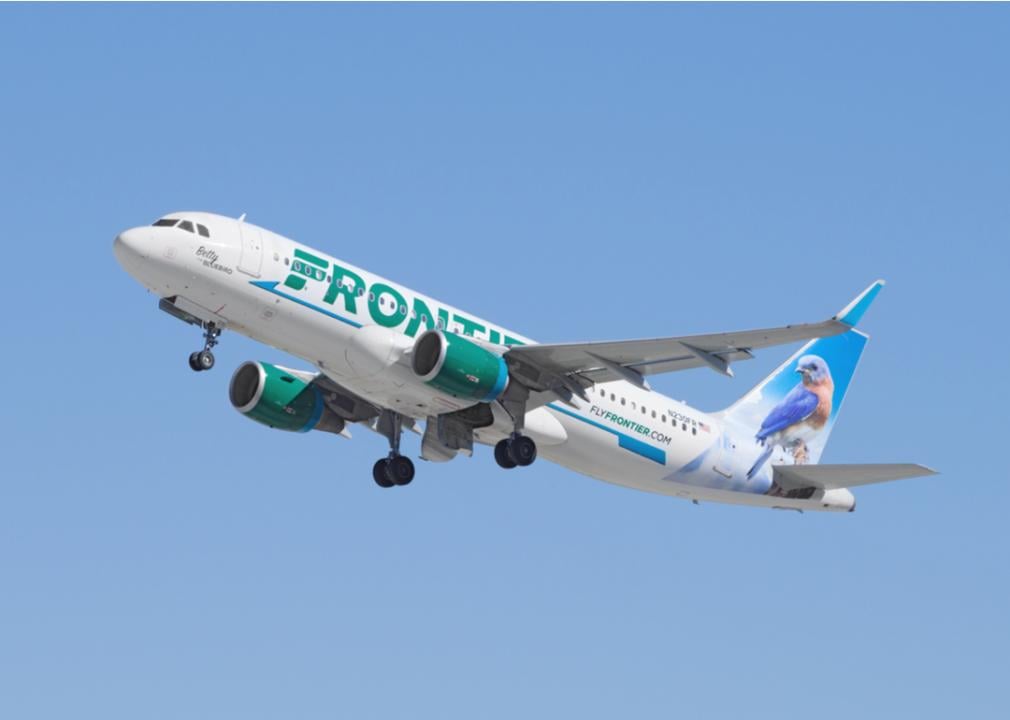
Angel DiBilio // Shutterstock
#3. Frontier Airlines Inc.
– On-time flights: 71.5%
– Airport with the most delayed flights: Fort Lauderdale, FL: Fort Lauderdale-Hollywood International
There’s one list that Frontier tops by a wide margin, but you won’t see it in any of the airline’s ads. It was #1 by far in the number of complaints per passenger between July 2020 and September 2021. Those complaints weren’t only about delays, but its on-time record is far from stellar, as you can see by its position in this ranking. Worst-case scenario: Your flight is delayed for hours while you’re stuck in Fort Lauderdale—the U.S. airport with the third-worst record for delays.
You may also like: History of gold and which countries have the most
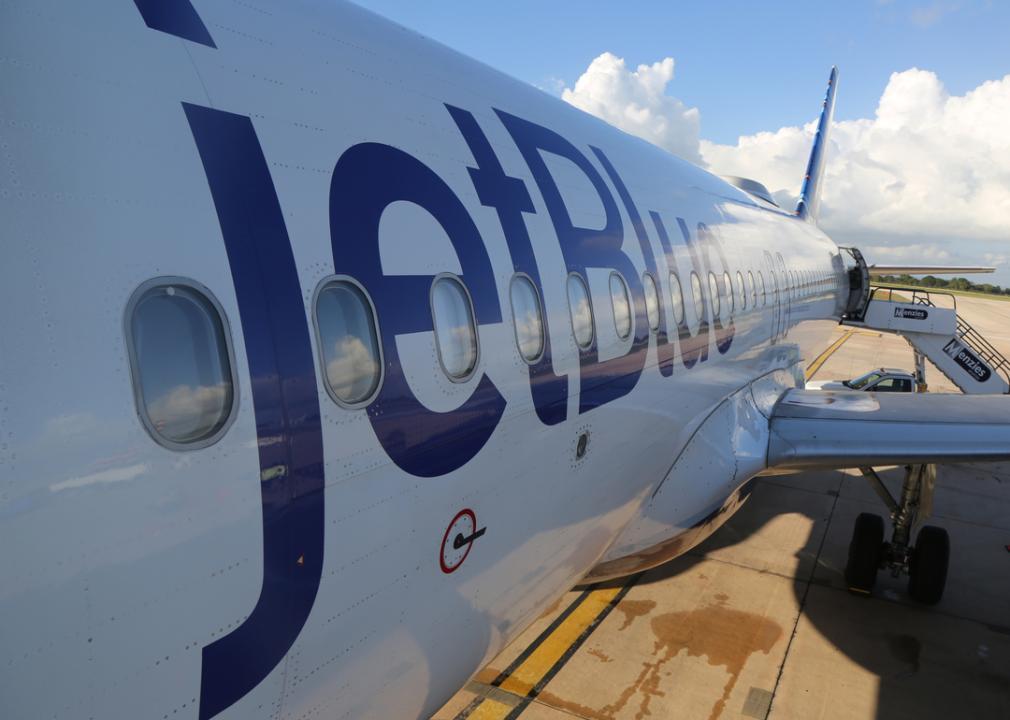
Leonard Zhukovsky // Shutterstock
#2. JetBlue Airways
– On-time flights: 69.4%
– Airport with the most delayed flights: Newark, NJ: Newark Liberty International
Maybe there’s a reason for the name. Too many JetBlue passengers sing the “Jet Blues” while waiting, sometimes for hours, at their boarding gates. The budget airline flies to more than 100 destinations throughout the Americas (as well as to London). Its on-time record is hurt by flying mostly to major cities with high air-traffic volume, but most of the major airlines do, too—and they have better on-time stats, which led the Wall Street Journal to declare JetBlue the worst airline in the U.S.
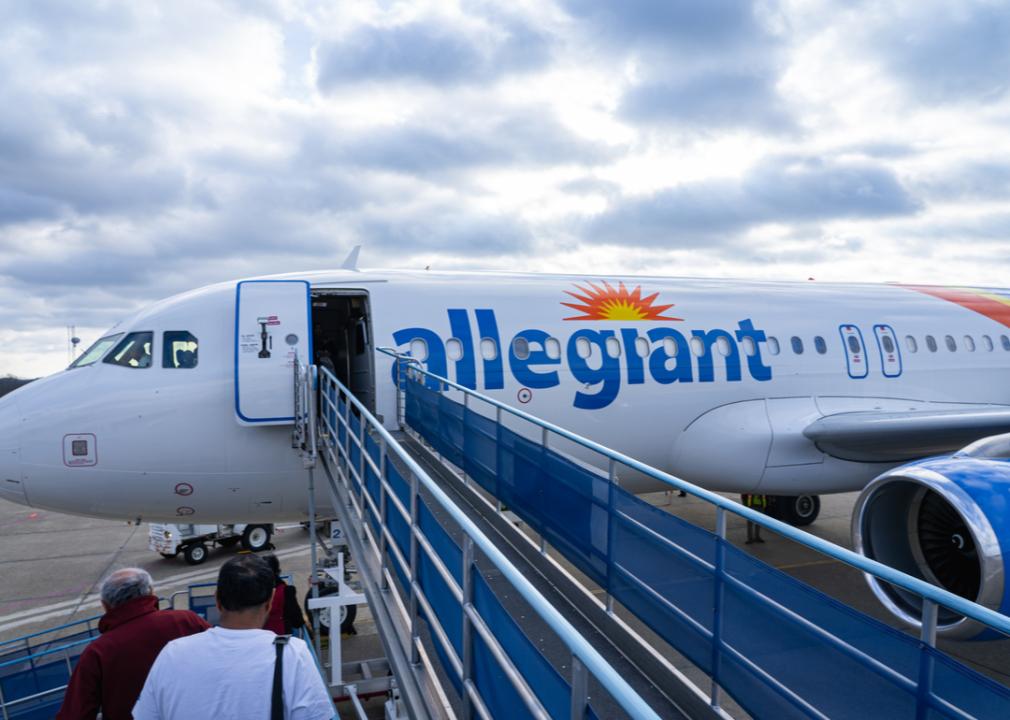
Eudaimonic Traveler // Shutterstock
#1. Allegiant Air
– On-time flights: 66%
– Airport with the most delayed flights: Punta Gorda, FL: Punta Gorda Airport
If a baseball team wins 66% of its games, it’s likely post-season-worthy. But if an airline is only on time 66% of the time, it’s … well, it’s Allegiant, which has a well-deserved reputation for delays and other problems (including a questionable safety record as revealed in a “60 Minutes” segment). In its defense, it’s an ultra-low-cost airline, so you’re essentially paying for the strong possibility that your flight won’t leave on time. On the bright side, if you’re in Punta Gorda, where delays are most common, you might have time to hit the sand for some extra tanning.
You may also like: History of oil in America
Founded in 2017, Stacker combines data analysis with rich editorial context, drawing on authoritative sources and subject matter experts to drive storytelling.
You may like

It’s well-documented that the surest, and often best, return on investments comes from playing the long game. But between stocks and real estate, which is the stronger bet?
To find out, financial planning firm Wealth Enhancement Group analyzed data from academic research, Standard and Poor’s, and Nareit to see how real estate compares to stocks as an investment.
Data going back to 1870 shows the well-established power of real estate as a powerful “long-run investment.” From 1870-2015, and after adjusting for inflation, real estate produced an average annual return of 7.05%, compared to 6.89% for equities. These findings, published in the 2019 issue of The Quarterly Journal of Economics, illustrate that stocks can deviate as much as 22% from their average, while housing only spreads out 10%. That’s because despite having comparable returns, stocks are inherently more volatile due to following the whims of the business cycle.
Real estate has inherent benefits, from unlocking cash flow and offering tax breaks to building equity and protecting investors from inflation. Investments here also help to diversify a portfolio, whether via physical properties or a real estate investment trust. Investors can track markets with standard resources that include the S&P CoreLogic Case-Shiller Home Price Indices, which tracks residential real estate prices; the Nareit U.S. Real Estate Index, which gathers data on the real estate investment trust, or REIT, industry; and the S&P 500, which tracks the stocks of 500 of the largest companies in the U.S.
High interest rates and a competitive market dampened the flurry of real-estate investments made in the last four years. The rise in interest rates equates to a bigger borrowing cost for investors, which can spell big reductions in profit margins. That, combined with the risk of high vacancies, difficult tenants, or hidden structural problems, can make real estate investing a less attractive option—especially for first-time investors.
Keep reading to learn more about whether real estate is a good investment today and how it stacks up against the stock market.
![]()

Wealth Enhancement Group
Stocks and housing have both done well
REITs can offer investors the stability of real estate returns without bidding wars or hefty down payments. A hybrid model of stocks and real estate, REITs allow the average person to invest in businesses that finance or own income-generating properties.
REITs delivered slightly better returns than the S&P 500 over the past 20-, 25-, and 50-year blocks. However, in the short term—the last 10 years, for instance—stocks outperformed REITs with a 12% return versus 9.5%, according to data compiled by The Motley Fool investor publication.
Whether a new normal is emerging that stocks will continue to offer higher REITs remains to be seen.
This year, the S&P 500 reached an all-time high, courtesy of investor enthusiasm in speculative tech such as artificial intelligence. However, just seven tech companies, dubbed “The Magnificent 7,” are responsible for an outsized amount of the S&P’s returns last year, creating worry that there may be a tech bubble.
While indexes keep a pulse on investment performance, they don’t always tell the whole story. The Case-Shiller Index only measures housing prices, for example, which leaves out rental income (profit) or maintenance costs (loss) when calculating the return on residential real estate investment.

Wealth Enhancement Group
Housing returns have been strong globally too
Like its American peers, the global real estate market in industrialized nations offers comparable returns to the international stock market.
Over the long term, returns on stocks in industrialized nations is 7%, including dividends, and 7.2% in global real estate, including rental income some investors receive from properties. Investing internationally may have more risk for American buyers, who are less likely to know local rules and regulations in foreign countries; however, global markets may offer opportunities for a higher return. For instance, Portugal’s real estate market is booming due to international visitors deciding to move there for a better quality of life. Portugal’s housing offers a 6.3% return in the long term, versus only 4.3% for its stock market.
For those with deep enough pockets to stay in, investing in housing will almost always bear out as long as the buyer has enough equity to manage unforeseen expenses and wait out vacancies or slumps in the market. Real estate promises to appreciate over the long term, offers an opportunity to collect rent for income, and allows investors to leverage borrowed capital to increase additional returns on investment.
Above all, though, the diversification of assets is the surest way to guarantee a strong return on investments. Spreading investments across different assets increases potential returns and mitigates risk.
Story editing by Nicole Caldwell. Copy editing by Paris Close. Photo selection by Lacy Kerrick.
This story originally appeared on Wealth Enhancement Group and was produced and
distributed in partnership with Stacker Studio.
Founded in 2017, Stacker combines data analysis with rich editorial context, drawing on authoritative sources and subject matter experts to drive storytelling.
Business
5 tech advancements sports venues have added since your last event
Published
6 days agoon
April 19, 2024
In today’s digital climate, consuming sports has never been easier. Thanks to a plethora of streaming sites, alternative broadcasts, and advancements to home entertainment systems, the average fan has myriad options to watch and learn about their favorite teams at the touch of a button—all without ever having to leave the couch.
As a result, more and more sports venues have committed to improving and modernizing their facilities and fan experiences to compete with at-home audiences. Consider using mobile ticketing and parking passes, self-service kiosks for entry and ordering food, enhanced video boards, and jumbotrons that supply data analytics and high-definition replays. These innovations and upgrades are meant to draw more revenue and attract various sponsored partners. They also deliver unique and convenient in-person experiences that rival and outmatch traditional ways of enjoying games.
In Los Angeles, the Rams and Chargers’ SoFi Stadium has become the gold standard for football venues. It’s an architectural wonder with closer views, enhanced hospitality, and a translucent roof that cools the stadium’s internal temperature.
The Texas Rangers’ ballpark, Globe Life Field, added field-level suites and lounges that resemble the look and feel of a sports bar. Meanwhile, the Los Angeles Clippers are building a new arena (in addition to retail space, team offices, and an outdoor public plaza) that will seat 18,000 people and feature a fan section called The Wall, which will regulate attire and rooting interest.
It’s no longer acceptable to operate with old-school facilities and technology. Just look at Commanders Field (formerly FedExField), home of the Washington Commanders, which has faced criticism for its faulty barriers, leaking ceilings, poor food options, and long lines. Understandably, the team has been attempting to find a new location to build a state-of-the-art stadium and keep up with the demand for high-end amenities.
As more organizations audit their stadiums and arenas and keep up with technological innovations, Uniqode compiled a list of the latest tech advancements to coax—and keep—fans inside venues.
![]()
Jeff Gritchen/MediaNews Group/Orange County Register // Getty Images
Just Walk Out technology
After successfully installing its first cashierless grocery store in 2020, Amazon has continued to put its tracking technology into practice.
In 2023, the Seahawks incorporated Just Walk Out technology at various merchandise stores throughout Lumen Field, allowing fans to purchase items with a swipe and scan of their palms.
The radio-frequency identification system, which involves overhead cameras and computer vision, is a substitute for cashiers and eliminates long lines.
RFID is now found in a handful of stadiums and arenas nationwide. These stores have already curbed checkout wait times, eliminated theft, and freed up workers to assist shoppers, according to Jon Jenkins, vice president of Just Walk Out tech.
Billie Weiss/Boston Red Sox // Getty Images
Self-serve kiosks
In the same vein as Amazon’s self-scanning technology, self-serve kiosks have become a more integrated part of professional stadiums and arenas over the last few years. Some of these function as top-tier vending machines with canned beers and nonalcoholic drinks, shuffling lines quicker with virtual bartenders capable of spinning cocktails and mixed drinks.
The kiosks extend past beverages, as many college and professional venues have started using them to scan printed and digital tickets for more efficient entrance. It’s an effort to cut down lines and limit the more tedious aspects of in-person attendance, and it’s led various competing kiosk brands to provide their specific conveniences.
Kyle Rivas // Getty Images
Mobile ordering
Is there anything worse than navigating the concourse for food and alcohol and subsequently missing a go-ahead home run, clutch double play, or diving catch?
Within the last few years, more stadiums have eliminated those worries thanks to contactless mobile ordering. Fans can select food and drink items online on their phones to be delivered right to their seats. Nearly half of consumers said mobile app ordering would influence them to make more restaurant purchases, according to a 2020 study at PYMNTS. Another study showed a 22% increase in order size.
Many venues, including Yankee Stadium, have taken notice and now offer personalized deliveries in certain sections and established mobile order pick-up zones throughout the ballpark.
Darrian Traynor // Getty Images
QR codes at seats
Need to remember a player’s name? Want to look up an opponent’s statistics at halftime? The team at Digital Seat Media has you covered.
Thus far, the company has added seat tags to more than 50 venues—including two NFL stadiums—with QR codes to promote more engagement with the product on the field. After scanning the code, fans can access augmented reality features, look up rosters and scores, participate in sponsorship integrations, and answer fan polls on the mobile platform.
Boris Streubel/Getty Images for DFL // Getty Images
Real-time data analytics and generative AI
As more venues look to reinvigorate the in-stadium experience, some have started using generative artificial intelligence and real-time data analytics. Though not used widely yet, generative AI tools can create new content—text, imagery, or music—in conjunction with the game, providing updates, instant replays, and location-based dining suggestions
Last year, the Masters golf tournament even began including AI score projections in its mobile app. Real-time data is streamlining various stadium pitfalls, allowing operation managers to monitor staffing issues at busy food spots, adjust parking flows, and alert custodians to dirty or damaged bathrooms. The data also helps with security measures. Open up an app at a venue like the Honda Center in Anaheim, California, and report safety issues or belligerent fans to help better target disruptions and preserve an enjoyable experience.
Story editing by Nicole Caldwell. Copy editing by Paris Close. Photo selection by Lacy Kerrick.
This story originally appeared on Uniqode and was produced and
distributed in partnership with Stacker Studio.
Founded in 2017, Stacker combines data analysis with rich editorial context, drawing on authoritative sources and subject matter experts to drive storytelling.
Business
Import costs in these industries are keeping prices high
Published
2 weeks agoon
April 11, 2024
Inflation has cooled substantially, but Americans are still feeling the strain of sky-high prices. Consumers have to spend more on the same products, from the grocery store to the gas pump, than ever before.
Increased import costs are part of the problem. The U.S. is the largest goods importer in the world, bringing in $3.2 trillion in 2022. Import costs rose dramatically in 2021 and 2022 due to shipping constraints, world events, and other supply chain interruptions and cost pressures. At the June 2022 peak, import costs for all commodities were up 18.6% compared to January 2020.
While import costs have since fallen most months—helping to lower inflation—they remain nearly 12% above what they were in 2020. And beginning in 2024, import costs began to rise again, with January seeing the highest one-month increase since March 2022.
Machinery Partner used Bureau of Labor Statistics data to identify the soaring import costs that have translated to higher costs for Americans. Imports in a few industries have had an outsized impact, helping drive some of the overall spikes. Crop production, primary metal manufacturing, petroleum and coal product manufacturing, and oil and gas extraction were the worst offenders, with costs for each industry remaining at least 20% above 2020.
![]()

Machinery Partner
Imports related to crops, oil, and metals are keeping costs up
At the mid-2022 peak, import costs related to oil, gas, petroleum, and coal products had the highest increases, doubling their pre-pandemic costs. Oil prices went up globally as leaders anticipated supply disruptions from the conflict in Ukraine. The U.S. and other allied countries put limits on Russian revenues from oil sales through a price cap of oil, gas, and coal from the country, which was enacted in 2022.
This activity around the world’s second-largest oil producer pushed prices up throughout the market and intensified fluctuations in crude oil prices. Previously, the U.S. had imported hundreds of thousands of oil barrels from Russia per day, making the country a leading source of U.S. oil. In turn, the ban affected costs in the U.S. beyond what occurred in the global economy.
Americans felt this at the pump—with gasoline prices surging 60% for consumers year-over-year in June 2022 and remaining elevated to this day—but also throughout the economy, as the entire supply chain has dealt with higher gas, oil, and coal prices.
Some of the pressure from petroleum and oil has shifted to new industries: crop production and primary metal manufacturing. In each of these sectors, import costs in January were up about 40% from 2020.
Primary metal manufacturing experienced record import price growth in 2021, which continued into early 2022. The subsequent monthly and yearly drops have not been substantial enough to bring costs down to pre-COVID levels. Bureau of Labor Statistics reporting shows that increasing alumina and aluminum production prices had the most significant influence on primary metal import prices. Aluminum is widely used in consumer products, from cars and parts to canned beverages, which in turn inflated rapidly.
Aluminum was in short supply in early 2022 after high energy costs—i.e., gas—led to production cuts in Europe, driving aluminum prices to a 13-year high. The U.S. also imposes tariffs on aluminum imports, which were implemented in 2018 to cut down on overcapacity and promote U.S. aluminum production. Suppliers, including Canada, Mexico, and European Union countries, have exemptions, but the tax still adds cost to imports.
U.S. agricultural imports have expanded in recent decades, with most products coming from Canada, Mexico, the EU, and South America. Common agricultural imports include fruits and vegetables—especially those that are tropical or out-of-season—as well as nuts, coffee, spices, and beverages. Turmoil with Russia was again a large contributor to cost increases in agricultural trade, alongside extreme weather events and disruptions in the supply chain. Americans felt these price hikes directly at the grocery store.
The U.S. imports significantly more than it exports, and added costs to those imports are felt far beyond its ports. If import prices continue to rise, overall inflation would likely follow, pushing already high prices even further for American consumers.
Story editing by Shannon Luders-Manuel. Copy editing by Kristen Wegrzyn.
This story originally appeared on Machinery Partner and was produced and
distributed in partnership with Stacker Studio.
Founded in 2017, Stacker combines data analysis with rich editorial context, drawing on authoritative sources and subject matter experts to drive storytelling.
Featured
-

 Business5 months ago
Business5 months agomesh conference goes deep on AI, with experts focusing in on training, ethics, and risk
-

 Business4 months ago
Business4 months agoSkill-based hiring is the answer to labour shortages, BCG report finds
-

 Events6 months ago
Events6 months agoTop 5 tech and digital transformation events to wrap up 2023
-

 People4 months ago
People4 months agoHow connected technologies trim rework and boost worker safety in hands-on industries
-

 Events3 months ago
Events3 months agoThe Northern Lights Technology & Innovation Forum comes to Calgary next month






